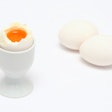
Approximately 30 percent of U.S. egg production is processed into liquid and frozen products for retail, foodservice, food manufacturing and export markets.Three general product categories are whole egg, yolk and albumen (or egg white). A smaller amount of egg production is also processed initially as liquid product and later dried as a very distinct final product.
Liquid egg products offer many advantages, such as ease of handling and storage but, most importantly, they are pasteurized, thus reducing risk of bacterial contamination.
Egg processing equipment
Standalone liquid egg production facilities must first process incoming eggs that arrive on palletized egg flats. Pallet unloading equipment may be semi-automatic or completely automated using robotics. Flats are then placed on conveyors that take them to a loader which transfers the eggs onto rollers and stacks empty flats for cleaning or disposal. Equipment is available to fully automate the cleaning and disinfection of plastic egg flats and pallets.
Many liquid egg processing plants are built as in-line facilities, meaning eggs arrive at the plant via conveyors directly from multiple laying houses at the same location. This arrangement reduces labor and transport expense, allowing for lower cost of production.
Eggs move along rollers into the washing system where they are cleaned with brushes and pressurized water to remove any shell contamination. They are then sanitized and receive a final rinse. Candling takes place after washing to identify dirty or leaking eggs or eggs with blood or meat spots, which are removed from the line.
Breaking machinery is offered at processing speeds from 7,000 to more than 225,000 eggs per hour. As eggs move through the conveyor, they are loaded into a breaking unit and supported by grippers on both ends of the egg. A side-by-side pair of knives cracks the shell from underneath the egg and then each knife moves independently, separating the egg shell halves and supports them to allow the contents to drain.
Breaker equipment is manufactured for whole egg liquid production or may include the option to separate yolks and albumen. The breaker machine is the most critical piece of equipment in the plant as extracting a maximum amount of properly separated yolk and egg white is the key to profitable production.

The breaker machine is critical for making sure the maximum amount of properly separated yolk and egg white is extracted. (Courtesy Moba)
If the separation design is used, the yolk slides gently into a yolk separator cup, which allows albumen to drain off through holes and/or over the sides of the yolk cup into an albumen cup below. The breaking unit is shaken to encourage draining of remaining albumen from the egg shell. All cups then move to separate collection areas where the yolk and albumen products are released. If producing whole egg product, both cups are dumped into the same collection vat.

Cups move to separate collection areas where the yolk and albumen products are released. If producing whole egg product, cups are dumped into the same collection vat. (Courtesy Sanovo Technology Group)
An optical scanning system is available that detects bits of yolk in the albumen cup. Those cups with yolk are then moved and dumped into a separate whole egg section, thus maintaining the product quality of the separate yolk and egg white in-process batches.
Liquid product is then moved to holding tanks before passing through a filtration system to ensure product quality and purity. After filtration, liquid egg product is cooled in holding tanks as quickly as possible to 39F to restrict bacteria growth. In a continuous flow system, product is moved directly into filtration and then continues to the next process.

Filtration systems are used to ensure product quality and purity during liquid egg production. (Courtesy Moba)
Pasteurization comes next to inactivate any remaining pathogens. The process involves quickly heating the product and maintaining a minimum required temperature for a specific time. As whole egg, yolk and albumen have different compositions, careful control must be taken to avoid denaturing the product during pasteurization.
Liquid egg storage
Liquid egg is then moved to storage holding tanks where it is again chilled. While in storage tanks, product may be blended to specific customer requirements of amount of yolk and egg whites. Also, characteristics such as water content, fat, protein, carbohydrates and pH may be standardized to meet specific product presentation specifications. There also may be blending with salt, sugar, preservatives, flavors or enzymes.
Packaging is the final step in the production process. Liquid eggs may be packaged for consumer and foodservice use in milk cartons, bottles, buckets or totes. Use of aseptic packaging allows up to six months of shelf life. Another option can be to ship liquid product directly to a customer in tanker trucks. Some processors also sell frozen liquid egg products, which have an even longer shelf life.
Egg shell processing
An optional egg shell processing operation is the final part of the production process. Rather than disposal, specialized equipment can transform egg shells into animal feed, fertilizer or even a component to produce floor tile.
Augers or pneumatic conveyors are used to move shells from the breaker machinery to a separate area for processing. A centrifuge is used to remove any remaining liquid that still may be stuck to shells. Some operations include that liquid in animal feed. Centrifugation or screw presses crush shells before they continue to a dryer. Once the moisture is removed, the shell product may be used as a source of calcium for animal feed or fertilizer.
Cleaning and regulations
Much of the equipment described in this article can be purchased with clean-in-place options, which eliminate the need to take apart, disinfect and reassemble the machine. Likewise, many of the controls are offered with manual, semi-automatic and fully automated options. Skilled personnel are an important key to successful production in order to ensure high final product standards are met.
A liquid egg production plant offers egg producers an opportunity to produce products that may be somewhat generic or can be customized for a more value-added market. These liquid egg products transform a business from a shell egg producer to a food producer which has regulatory, distribution and liability implications that must be managed to ensure the success of this investment.
Liquid egg processing products
Suppliers to the liquid egg processing industry share information on what makes their products unique in the marketplace.
Sanovo manufactures liquid egg plant equipment.
- Electronic dirt detection-rejection saves manual labor before the breaker machine
- Unique yolk and white cup designs that accommodate all egg sizes and offer maximum drainage, excellent separation and very dry yolks
- Patented cracker head design tilts and gently shakes the egg to fully drain white from shell
- Yolk and white cups move away from shell after breaking which pulls egg white to maximize yield (amount of liquid extracted from egg shell)
- Special egg scanning technology looking through albumen cup for yolk remnants results in reduced whole egg in egg white product
- Patented monitoring system alerts operator if a cracker head is not breaking properly or if separation is not functioning correctly
- Optional Wave Technology pasteurization to maximize final product shelf life and functional properties
- Offer custom end product development with exclusivity agreements
Moba also manufactures liquid egg plant equipment.
- Egg breaker capacity up to 626 cases per hour
- Exceptional yield
- High quality and low fat in egg white product
- Pelbo Pure option extends pasteurization run time and improves homogenization and functional properties of finished product
- Range designed to reduce cost of ownership with easy cleaning, as well as reduced chemical and water use
- Offer complete solutions to achieve desired functional properties of finished product
- Outstanding sales and after-sale customer service
Ovo-Vision offers software for the liquid egg production operation.
- Interfaces with manufacturing equipment
- Provides customer forecast and production planning for specific products
- Opportunity to include product and/or customer specifications
- Includes accounting, sales, purchasing, inventory and warehouse management, production formulas and filling information
- Integrates quality control functions
- Interfaces with electronic data interchange systems
Vincent Corp. produces equipment for egg shell processing.
- Screw press extracts liquid and crushes egg shells
- Low operating and maintenance expense
- Multiple sizes available to meet any operation’s needs
















